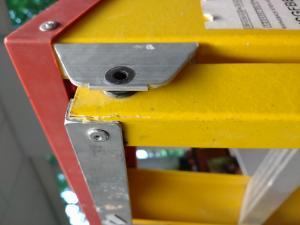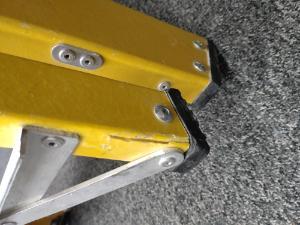Work at height and safe use of stepladders
Further Useful Information
- What is work at height?
- Introduction to stepladders
- Training
- Risk assessment
- Scheduled inspection of stepladders
- Pre-use visual checks of stepladders
- Stepladder standards
- Step stools/kick stools
What is work at height?
'Work at height' means work in any place where, if there were no precautions in place, a person could fall a distance liable to cause personal injury (for example falling off a ladder/stepladder) and represents one of the biggest causes of fatalities and major injuries in the workplace.
Introduction to stepladders
Stepladders are commonly used throughout the Department as a quick and easy means of access to work areas (eg high storage shelving). However, they need to be used with care to avoid injury. Stepladders must only be used for tasks of low risk and short duration (less than 30 minutes).
The following sections outline departmental policy along with simple, practical measures that need to be taken to reduce risk from using stepladders.
Training
All stepladder users must be ‘competent’ to use a stepladder safely. However, this does not require attending formal training e.g. training delivered by an external provider. Competence can be achieved by being given simple instructions that can be delivered ‘on the job’.
Departmental users of stepladders should complete the following training:
- Local ‘on the job’ instruction on safe use of a stepladder for specific task(s) (a minimum training requirement that should be recorded).
- Local ‘on the job’ training should be supplemented by the following training- particularly for those performing routine stepladder tasks in their job:
- Online ‘Ladder Safety’ (includes stepladders) training available on the Learning and Management System (search for ‘Ladder Safety’ training)
- And/or view the step ladder / step stool safety awareness training presentation
Risk assessment
Stepladders must only be used for tasks of low risk and short duration (less than 30 minutes). The ad hoc use of a stepladder required for obvious simple ‘light’ tasks (eg accessing shelving in an office/lab) satisfies this criteria.
Although a specific written risk assessment is not required for such obvious low risk activities, users must ensure:
- that the stepladder is appropriate for the task
- be ‘competent’ (ie received instruction on safe use of the stepladder)
- the ladder can be used in a level and stable area
Greater consideration, in the form of a specific written risk assessment, is required for less obvious ‘low risk’ work at height tasks eg more complex tasks involving handling heavy items or tasks that may not be easy to access using a stepladder. In these cases the risk assessment needs to justify the use of a ladder/stepladder.
Points to consider
- Is the task of short duration (less than 30 minutes)?
- Can the job be easily accessed from a stepladder?
- Is the job of low risk (job of uncomplicated nature that can be performed easily from the ladder)?
- Has the correct type and size of stepladder been selected for the job?
- Is there sufficient space to erect the stepladder properly?
- Is the ground level, firm and stable?
- Are any measures required to protect other people (eg barriers/second person to act as a look out, near a door or fire exit)?
- Are the person(s) carrying out the work ‘competent’ to use the stepladders safely for the task (ie received appropriate information, instruction or training)?
- Are the person(s) fit to do the task (ie capable of climbing a stepladder safely/not fearful of heights)?
Scheduled inspection of stepladders
All departmental stepladders must be inspected at least 12 monthly and six monthly for frequently used ladders (eg ladders used several times a week).
Biology Infrastructure are responsible for organising and performing visual inspections of stepladders (similar to the pre-use visual checks) to spot defects. A record is retained of the last inspection.
Inspections look for:
- damaged or worn stepladder feet
- twisted, bent or dented stiles (vertical parts attached to steps)
- damaged locking mechanisms
- damaged stepladder platform
- damaged or worn steps / treads
- Ladder checklist
Examples of ladder damage: crack in ladder/damaged feet
All stepladders must have an inspection tag to record inspection dates.
Pre-use visual checks of stepladders
Users should check that the stepladder is safe to use by carrying out the following visual checks:
- Check the stiles (the vertical parts attached to the steps): are they bent or otherwise damaged?
- Check the feet: are any missing, worn, damaged or dirty (e.g. soil, chippings or embedded stones) that could cause the ladder to slip?
- Check any locking mechanisms: are any bent or the fixings worn or damaged that could cause the ladder to collapse. Also ensure any locking bars are engaged.
- Check the stepladder platform: is it split or buckled that could cause the ladder to become unstable or collapse?
- Check the steps or treads on stepladders: is there anything on the steps that could cause them to be slippery? Are any fixings loose on the steps that could cause them to collapse?
Any defective stepladders must be immediately removed from use and Biol-Infrastructure contacted to arrange disposal.
Stepladder standards
- EN131 is the current required standard for portable stepladders and ladders
- BS2037 and BS1129 standards have been withdrawn. However they can still be used subject to following user instructions and guidance on safe use‘
- 'Domestic’ ladders (non-professional use) are generally not recommended for use in the workplace setting. Their use in the department is therefore restricted to simple, ‘light’ tasks of low frequency only (eg infrequent access to shelving in office/lab facilities).
- ‘Professional’ ladders are more durable than ‘domestic ladders’ and designed for more demanding tasks (eg in onerous conditions) of greater frequency as performed by tradespeople. In the department they must be used for all tasks involving:
- frequent use of stepladders
- frequent movement of stepladders
Step stools/kick stools
A kick-step or step stool is not a ladder/stepladder and does not have stability issues associated with a standing ladder/stepladder. They are designed not to move when you stand on one. Therefore you do not need to complete the University ladder/stepladder training session in order to use one. However there are hazards of which you should be aware.
Step stool do’s & don’ts
Do's
- Be familiar with how to use it- if in doubt ask.
- Wear sensible ‘closed’ shoes that will not slip on the stool’s surfaces.
- Avoid wearing clothes in which you could catch your heel when mounting the step.
- Use alternative access equipment if you cannot comfortably reach and handle the materials being stored at height with a step stool.
Don'ts
- Don’t use a step stool if it is damaged. Rubber grips on the base of step stools normally stop it from moving when you stand on it. If the rubber is damaged it will increase the risk that the stool could move when in use.
- Don’t overreach or stretch during use. Be prepared to move the step into a new position rather than risk overreaching for access to an item, and subsequently losing your balance.


